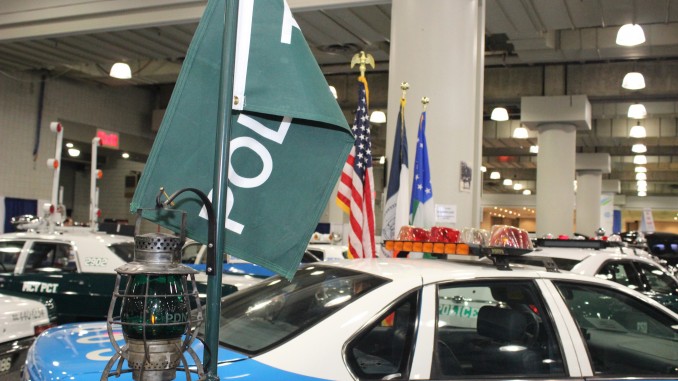
![]()
There are few examples of the green colored “Command Post” flags and lanterns that were utilized a century ago by the Police Department of the City of New York (PDNY/NYPD) to designate a “Command Post” at the scene of a fire or other large emergency. Collectors have examples in their collections, and according to sources within the NYPD, there is/was at least one flag inside of the Chief of Patrol’s office at Headquarters, located at One Police Plaza. There are also few photographs of the actual flag and lantern from the period that were used by the PDNY. So why, when and by whom were the Command Post flags and lanterns adopted and how were they utilized?
The earliest reference, to date, to the green colored flag and lamp was found in an article, published on May 25, 1915, in “The Daily Standard Union: Brooklyn.” The article relates that on that date, Police Commissioner (PC) Arthur Woods “announced that a new system in handling crowds at a fire will soon be inaugurated. The first policeman arriving at the scene of a fire will take charge of the crowds until the arrival of a superior officer. A green flag will be placed in front of a store in the neighborhood where there is a telephone pay station, and this will be used as a headquarters by police. At night, a green lamp will be used for this purpose.”
The public telephone system was the means of voice communication between officers, precincts, and headquarters. This idea would solve many problems faced at such scenes. The flag and lanterns were kept in the precinct station-houses and were brought to the scene of an emergency to designate a Command Post where superior officers, and other officials, could assemble to manage the fire, or emergency scene. Next time you are in, or see, the latest multi-million dollar mobile Command Posts, packed with the latest technology, just remember their humble beginnings and PC Arthur Woods.
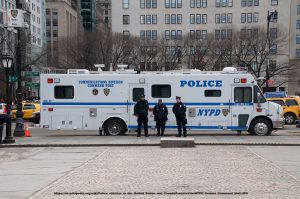
The prescribed manner in which the Command Post Flag & Lantern were to be deployed was specified in the “Rules and Regulations” (“R&R”) of the PDNYC. The R&R book, issued in December 1940, specifies “In case of fire, riot, or other emergency, the member of the Force first on the scene shall be in charge of the police functions until the arrival of one of higher rank, who shall then assume command.” It continues in another paragraph “If the emergency is serious, the member of the force shall establish without unnecessary delay, headquarters convenient to the scene of the disturbance, and near a telephone, and shall station a messenger there to transmit necessary messages. When the flag or lantern is brought from the station-house, he shall display it at headquarters.” Radio communications had not yet been established in the PDNYC.
Similarly, the “Rules and Procedures” of 1956, specifies that the first arriving officers establish a temporary headquarters and listed the duties of the first arriving officers which concluded with a statement that the officer was notify the precinct Desk Officer “To send a temporary headquarters flag, green lantern and Temporary Headquarters Log.” Of interest is the last line which reads “If the Temporary Headquarters vehicle is required, it shall be requested.” By 1955, two-way radio communication had been established as it was in 1946 that borough-wide two-way radio communication was established, and it happened in Staten Island.
Why green? Green is the traditional color of “New York’s Finest,” being used since at least 1871 in the glass lenses of lamps outside of each precinct station-house. The traditional explanation for this color, and the custom of green colored lamps outside of police stations, dates back to the late seventeenth century with the Dutch possession of the city, known then as “New Amsterdam.” In that era, “The City Watch,” comprised of Watchmen, who patrolled the dark streets carrying lamps which were hung outside of their small “Watch Houses” when they were inside the “house.” This, it is said, was a signal to the citizenry that the “the Watchman is in the house.” However, (to date) a written description of the color of the lamps carried by the Watchmen was not found.
There are even fewer photographs of the flag and lantern than there are physical examples of the same. One example, depicted below, in two different photographs, from two different sources, was taken in the year 1955. One photograph from the “Getty Images” website, was originally sourced to the archives of the “New York Daily News” newspaper and accompanied an article, published on July 1, 1955. See the photo and caption (insert) for an image of the flag and lantern. A second image sourced to “Life Magazine” from 1955, taken from a slightly different angle, provides a rare glimpse of the actual pole, hardware, flag and lantern.
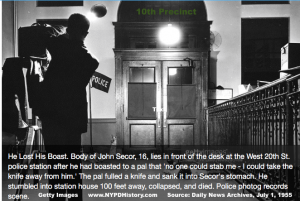
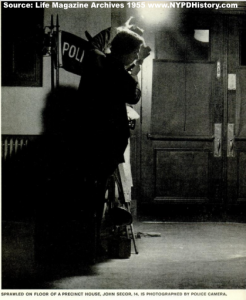
As seen in the photos, it appears that the flag is rigid. This was likely the result of the manner in which the flag was mounted as can be seen in the photo below, which is credited to an NYPD source who indicated that the flag is/was in the office of the Chief of Patrol.
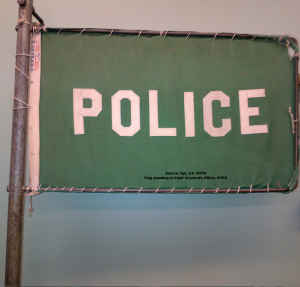
“What’s the Deal With:” the first use of the green colored Command Post flags and lanterns used by the PDNY in the last century? In 1915, PC Arthur Woods, addressed the need for emergency scenes to have an identifiable, centralized, location with access to a telephone, marked by a green colored flag and green colored lantern. These flags and lanterns were used by the PDNY into the 1960s. Few examples of, and photographs of, the “Command Post” flag and lantern exist.

![]()
Editor’s Note: Amended April 18, 2016 to include two paragraphs about Rules & regs dealing with CP Flag & Lantern.

Leave a Reply
You must be logged in to post a comment.